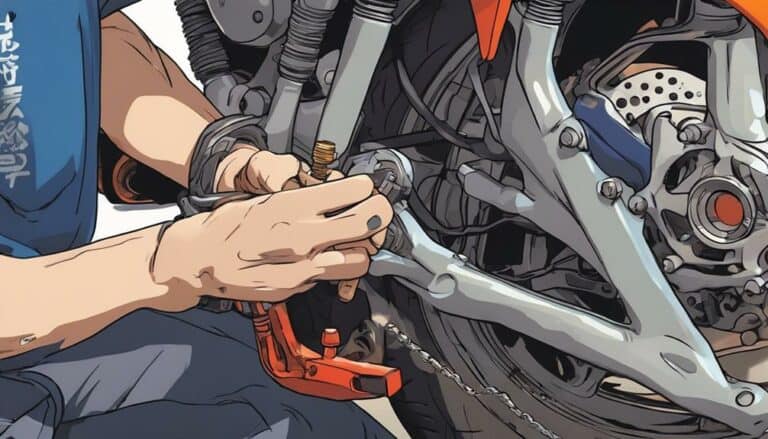When it comes to tightening the valve stem nut on your dirt bike, remember: not all nuts are created equal. Finding that sweet spot of just-right tightness can be the difference between a smooth ride and a rocky one.
But how tight is too tight? Well, that's where things get interesting.
Key Takeaways
- Proper valve stem nut tightness prevents sudden pressure loss and maintains tire integrity.
- Recommended torque specs range from 3 to 5 ft-lbs to avoid damage.
- Signs of over-tightening include tears, cracks, and difficulty with tire inflation.
- Regularly adjust nut tightness based on tire pressure levels for safety and performance.
Importance of Proper Valve Stem Nut Tightness
Proper valve stem nut tightness is essential for maintaining tire integrity and preventing potential hazards while riding. The valve stem nut plays a vital role in securing the valve stem to the tube, ensuring that it remains in place even when the tire experiences movement on the rim. By keeping the nut appropriately tightened, you reduce the risk of the valve stem tearing off the tube, which could lead to sudden loss of pressure or even blowouts during your ride. Maintaining the correct tightness of the valve stem nut is paramount for preserving the integrity of tire pressure, ultimately contributing to enhanced safety and performance on your dirt bike.
Regularly checking and adjusting the tightness of the valve stem nut is a fundamental aspect of maintenance that shouldn't be overlooked. This simple yet critical task can help prevent costly flat tire incidents, offering you peace of mind while you enjoy your off-road adventures. Remember, ensuring the valve stem nut is secure isn't just about avoiding inconveniences; it's about prioritizing your safety and optimizing your bike's overall performance.
Recommended Torque Specs for Valve Stem Nut
For precise installation of the valve stem nut on your dirt bike, adhere to the recommended torque specifications ranging from 3 to 5 ft-lbs. Following these guidelines is important to avoid potential damage and guarantee excellent performance and safety.
- Recommended Torque Specs: The torque specs for the valve stem nut typically range from 3 to 5 ft-lbs, as per manufacturer's guidelines.
- Avoid Over-Tightening: Over-tightening the nut can lead to damage to the valve stem or tube, compromising the integrity of the tire.
- Use a Torque Wrench: Utilizing a torque wrench is essential to achieve the recommended torque accurately and prevent under or over-tightening.
- Ensure Safety and Performance: Properly tightening the valve stem nut isn't only about preventing air loss but also about maintaining safety and performance during your rides.
Signs of Over-Tightened Valve Stem Nut
Inspecting the valve stem for signs of damage is important to identifying potential issues resulting from an over-tightened valve stem nut on your dirt bike. Over-tightening the valve stem nut can lead to damage such as tears or cracks in the valve stem, which can result in difficulties with tire inflation or even lead to air leaks.
Signs of an over-tightened valve stem nut may manifest as the valve stem tearing, making it vital to inspect the valve stem for any deformities. Excessive tightening can also cause premature wear on the valve stem, affecting its integrity.
Properly snug, but not overly tight, valve stem nuts are essential to maintain the best tire pressure and preserve the integrity of the valve. Regular inspection of the valve stem for any signs of damage is key to ensuring that the valve stem nut is adjusted correctly to prevent any potential issues with tire inflation or valve integrity.
Tips for Adjusting Valve Stem Nut Tightness
To guarantee proper tire pressure and valve integrity, adjust the tightness of the valve stem nut according to recommended pressure levels.
When adjusting the valve stem nut tightness on your dirt bike, consider the following tips:
- Secure Fit: Make sure the nut is secure to prevent stem tearouts during tire mounting.
- Security Measure: Adjust the nut tightness based on tire pressure levels for best security.
- Stability Enhancement: Use the nut as a locknut against the valve cap to enhance stability.
- Regular Maintenance: Regularly check and adjust the nut tightness to avoid air loss and potential issues.
Maintenance Schedule for Valve Stem Nut
When maintaining the valve stem nut on your dirt bike, make sure it is snug against the valve stem cap to avoid damage during tire mounting. Proper tightening of the valve stem nut is essential for maintaining tire pressure integrity and preventing sudden pressure loss. Regularly checking and adjusting the valve stem nut should be part of your maintenance schedule to guarantee peak performance. Nut placement against the valve stem cap is vital for securing the valve stem in place and preventing potential damage.
| Maintenance Task | Frequency | Importance |
|---|---|---|
| Check valve stem nut | Before each ride | Damage prevention |
| Adjust nut tightness | Every 3 months | Proper tightening |
| Follow manufacturer guidelines | Annually | Performance |
Conclusion
Guarantee your valve stem nut is tightened just right to strike the perfect balance between security and flexibility. Over-tightening can lead to issues like tire slipping or blowouts.
Remember, snug but not too tight is the key to maintaining tire pressure integrity and preventing flat tire incidents. Keep your dirt bike in top condition by following the recommended torque specs and regular maintenance schedule for your valve stem nut.

